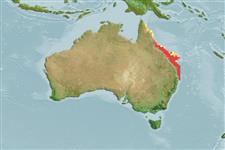Klassifizierung / Names
Namen | Synonyme | Catalog of Fishes(Gattung, Arten) | ITIS | CoL | WoRMS | Cloffa
Elasmobranchii (Haie und Rochen) (sharks and rays) >
Orectolobiformes (Carpet sharks) >
Brachaeluridae (Blind sharks)
Etymology: Brachaelurus: brachys (Gr.), short, referring to short and stout body; aelurus, from ailouros (Gr.), cat, i.e., a short catshark (See ETYFish); colcloughi: In honor of Ogilby’s friend John Colclough, Amateur Fisherman’s Association of Queensland, who collected many specimens for Ogilby (See ETYFish).
Eponymy: John Colclough was a friend of the author. He was a keen fisherman, member of the Amateur Fisherman’s Association of Queensland and collector, and later sent a considerable collection to Ogilby from the Aru Islands and the Northern Territory of Australia. (Ref. 128868), visit book page.
More on author: Ogilby.
Issue
See CofF and Ref. 48863.
Environment: milieu / climate zone / depth range / distribution range
Ökologie
seewasser demersal; tiefenbereich 4 - 217 m (Ref. 106604). Subtropical; 12°S - 29°S, 143°E - 154°E
Southwest Pacific: endemic to Australia.
Size / Gewicht / Alter
Maturity: Lm ? range ? - ? cm
Max length : 76.0 cm TL Männchen/unbestimmt; (Ref. 13576)
Rückenflossenstacheln (insgesamt) : 0; Afterflossenstacheln: 0. No white spots on body (Ref. 13576). Caudal fin with its upper lobe at a low angle above body axis, with a strong terminal lobe and subterminal notch but no ventral lobe (Ref. 13576).
A little-known shark found on the continental shelf close inshore (Ref. 247). Feeds on benthic invertebrates (Ref. 43278). Ovoviviparous (Ref. 43278, 50449).
Life cycle and mating behavior
Geschlechtsreife | Fortpflanzung | Ablaichen | Eier | Fecundity | Larven
Ovoviviparous, embryos feed solely on yolk (Ref. 50449). Distinct pairing with embrace (Ref. 205).
Goto, T., 2001. Comparative anatomy, phylogeny and cladistic classification of the order Orectolobiformes (Chondrichthyes, Elasmobranchi). Mem. Grad. Sch. Fish. Sci. Hokkaido Univ. (MGSFSHU), v. 48 (no. 1):1-100. (Ref. 48863)
IUCN Rote Liste Status (Ref. 130435: Version 2024-1)
Bedrohung für Menschen
Harmless
Nutzung durch Menschen
Fischereien: weniger kommerziell
Tools
Zusatzinformationen
Download XML
Internet Quellen
Estimates based on models
Preferred temperature (Ref.
123201): 23.7 - 25.5, mean 24.7 °C (based on 50 cells).
Phylogenetic diversity index (Ref.
82804): PD
50 = 1.0000 [Uniqueness, from 0.5 = low to 2.0 = high].
Bayesian length-weight: a=0.00389 (0.00180 - 0.00842), b=3.12 (2.94 - 3.30), in cm total length, based on all LWR estimates for this body shape (Ref.
93245).
Trophic level (Ref.
69278): 3.5 ±0.37 se; based on food items.
Widerstandsfähigkeit (Ref.
120179): niedrig, Verdopplung der Population dauert 4,5 - 14 Jahre. (Fec assumed to be <100).
Fishing Vulnerability (Ref.
59153): Moderate to high vulnerability (50 of 100).
